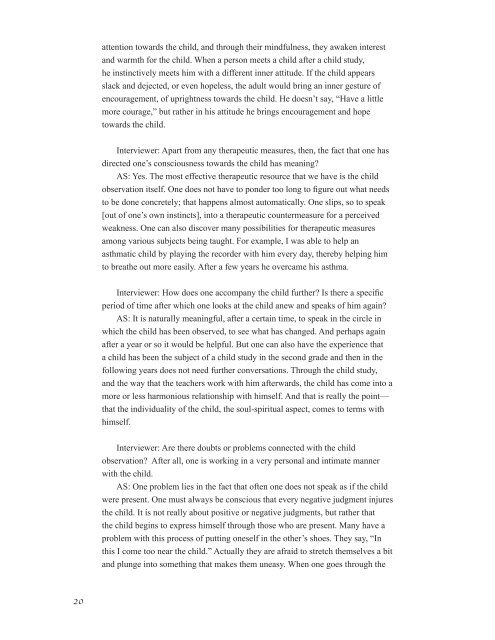Observing the Class Observing the Children - Research Institute for ...
Observing the Class Observing the Children - Research Institute for ...
Observing the Class Observing the Children - Research Institute for ...
Create successful ePaper yourself
Turn your PDF publications into a flip-book with our unique Google optimized e-Paper software.
20<br />
attention towards <strong>the</strong> child, and through <strong>the</strong>ir mindfulness, <strong>the</strong>y awaken interest<br />
and warmth <strong>for</strong> <strong>the</strong> child. When a person meets a child after a child study,<br />
he instinctively meets him with a different inner attitude. If <strong>the</strong> child appears<br />
slack and dejected, or even hopeless, <strong>the</strong> adult would bring an inner gesture of<br />
encouragement, of uprightness towards <strong>the</strong> child. He doesn’t say, “Have a little<br />
more courage,” but ra<strong>the</strong>r in his attitude he brings encouragement and hope<br />
towards <strong>the</strong> child.<br />
Interviewer: Apart from any <strong>the</strong>rapeutic measures, <strong>the</strong>n, <strong>the</strong> fact that one has<br />
directed one’s consciousness towards <strong>the</strong> child has meaning?<br />
AS: Yes. The most effective <strong>the</strong>rapeutic resource that we have is <strong>the</strong> child<br />
observation itself. One does not have to ponder too long to figure out what needs<br />
to be done concretely; that happens almost automatically. One slips, so to speak<br />
[out of one’s own instincts], into a <strong>the</strong>rapeutic countermeasure <strong>for</strong> a perceived<br />
weakness. One can also discover many possibilities <strong>for</strong> <strong>the</strong>rapeutic measures<br />
among various subjects being taught. For example, I was able to help an<br />
asthmatic child by playing <strong>the</strong> recorder with him every day, <strong>the</strong>reby helping him<br />
to brea<strong>the</strong> out more easily. After a few years he overcame his asthma.<br />
Interviewer: How does one accompany <strong>the</strong> child fur<strong>the</strong>r? Is <strong>the</strong>re a specific<br />
period of time after which one looks at <strong>the</strong> child anew and speaks of him again?<br />
AS: It is naturally meaningful, after a certain time, to speak in <strong>the</strong> circle in<br />
which <strong>the</strong> child has been observed, to see what has changed. And perhaps again<br />
after a year or so it would be helpful. But one can also have <strong>the</strong> experience that<br />
a child has been <strong>the</strong> subject of a child study in <strong>the</strong> second grade and <strong>the</strong>n in <strong>the</strong><br />
following years does not need fur<strong>the</strong>r conversations. Through <strong>the</strong> child study,<br />
and <strong>the</strong> way that <strong>the</strong> teachers work with him afterwards, <strong>the</strong> child has come into a<br />
more or less harmonious relationship with himself. And that is really <strong>the</strong> point—<br />
that <strong>the</strong> individuality of <strong>the</strong> child, <strong>the</strong> soul-spiritual aspect, comes to terms with<br />
himself.<br />
Interviewer: Are <strong>the</strong>re doubts or problems connected with <strong>the</strong> child<br />
observation? After all, one is working in a very personal and intimate manner<br />
with <strong>the</strong> child.<br />
AS: One problem lies in <strong>the</strong> fact that often one does not speak as if <strong>the</strong> child<br />
were present. One must always be conscious that every negative judgment injures<br />
<strong>the</strong> child. It is not really about positive or negative judgments, but ra<strong>the</strong>r that<br />
<strong>the</strong> child begins to express himself through those who are present. Many have a<br />
problem with this process of putting oneself in <strong>the</strong> o<strong>the</strong>r’s shoes. They say, “In<br />
this I come too near <strong>the</strong> child.” Actually <strong>the</strong>y are afraid to stretch <strong>the</strong>mselves a bit<br />
and plunge into something that makes <strong>the</strong>m uneasy. When one goes through <strong>the</strong>

















